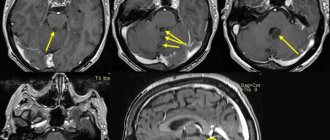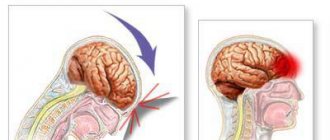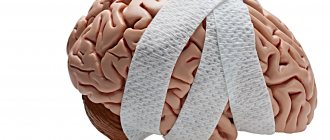What should you pay attention to in order to suspect a tumor in time?
The main symptoms of a brain tumor in children and adolescents:
- persistent or recurring vomiting;
- persistent or recurring headaches;
- problems with coordination or walking;
- blurred vision, double vision;
- unnatural eye movements;
- abnormal head position;
- seizures or convulsions;
- behavioral changes, especially fatigue;
- increase in head circumference in infants;
- delayed puberty in adolescents.
Headache, nausea and vomiting, difficulty swallowing
Olga Zheludkova, pediatric oncologist of the highest category, Doctor of Medical Sciences, Professor of the Russian Scientific Center of X-ray Radiology:
“Headache - especially increasing pain - is a common symptom of a brain tumor. Usually it looks like this: I had a headache, my mother gave me a pill, a week later it happened again, a day later it happened again. Another common symptom is vomiting in the morning, which brings relief. The child gets out of bed, vomits, and feels better. Parents should be alarmed when this occurs not for the first time, but repeatedly, within a week or month. It is important to understand that ordinary gastroenterological problems, as a rule, recur every day, and vomiting with brain tumors may not be daily, but once every three days or once a week. And vomiting due to brain tumors does not fade over time, but, on the contrary, increases. Parents who notice this should urgently go to an ophthalmologist and ask him to look at the fundus and evaluate the child’s visual acuity, even if there are no obvious vision problems. And with this data, go to a neurologist. You should also be wary when there is a swallowing disorder. Usually it manifests itself as follows: while eating liquid food, the child develops coughing and choking.”
Should behavioral changes be cause for concern?
Sudden changes in a child’s mood, situations where a child becomes irritable for no reason and loses control over his actions, or situations where a previously very active child becomes drowsy and lethargic - in all these cases, parents should seek advice from a specialist.
Uncontrollable laughter or crying for no reason, a state of euphoria that turns into aggressive behavior, mood swings or sudden attacks of fear can also be a cause for anxiety. Children with a brain tumor often experience hallucinations. But children cannot say this, so parents must monitor their behavior.
Neurosurgeon Konstantin Kardash consults adults and children
Convulsions, weakness, loss of consciousness
Vladimir Solovyov, neurologist-epileptologist, head of the laboratory for pre-surgical diagnosis of epilepsy at the Morozov Children's City Clinical Hospital, doctor at the video-EEG laboratory of the Epilepsy Center:
“The main neurological symptoms of a brain tumor, in addition to headaches, are seizures and loss of consciousness. Of course, anyone can faint: for example, this happens with children of asthenic physique, or with overwork and hormonal changes in the body. But if a disturbance of consciousness occurs unexpectedly, without physical activity, then this is a reason to go to the doctor. In any case, seizures should also be seen by specialists. Very young children may experience febrile seizures - seizures during fever and infectious diseases. Most likely, such seizures will not be a symptom of a brain tumor, but it is still necessary to exclude this. Well, if attacks bother children older than one year, then this is definitely a reason to consult a doctor.
Another symptom is general weakness. He should be alert if this happens systematically, if it is clear that the child is not pretending. It’s one thing when he doesn’t want to go to school in the morning, and it’s a completely different thing when you and your whole family go to the zoo, and the child doesn’t have the strength, although he always really wanted to go there.
Unfortunately, specialists do not always immediately prescribe the necessary examinations for children. In my practice, I often encounter the fact that instead of an MRI, children are referred for an ultrasound of the brain vessels. Doctors suspect vasoconstriction, which allegedly causes chronic oxygen deprivation and headaches. Some people even try to blame it on a migraine, but how can a six-year-old child get a migraine? Then the parents themselves do an MRI, and there the tumor is in an advanced stage. This also happens.
At my appointments, I always advise parents to get a second opinion, especially when it comes to a serious illness. If parents suspect something, it is better to hear from a second specialist. Moreover, if the doctor at the appointment without hesitation says that there is no need to do an MRI, that everything is fine - it’s just a headache and will go away soon. It is important to remember that even one of the above symptoms is enough to consult a specialist.”
What are the main causes of tumors in children?
Some tumors are hereditary. For example, one of the common genetic diseases treated by neurosurgeon Konstantin Kardash is neurofibromatosis (Recklinghausen disease).
The mechanisms of development of brain tumors in children are not fully understood; presumably, these are radiation, hormonal imbalances, viral infections and environmental factors that are considered carcinogenic. We only know for certain that the cause of tumor development is radiation - this has been confirmed by scientific research.
Unfortunately, many carcinogens are found in everyday life. Of course, this is not a reason to abandon the basic benefits of civilization, but they must be used consciously:
- high voltage power lines,
- electromagnetic radiation from mobile communications,
- sweetener (aspartame),
- gas used in the production of plastics (vinyl chloride).
Growth problems, delayed puberty or early puberty, diabetes insipidus
Nadezhda Mazerkina, endocrinologist of the highest category, Doctor of Medical Sciences, doctor of the children's department of the National Medical Research Center for Neurosurgery named after. ak. N. N. Burdenko:
“Parents should first of all be alert to the following symptoms: growth retardation, premature or late puberty, as well as symptoms of diabetes insipidus: thirst and polyuria - that is, a frequent urge to go to the toilet, especially at night. If a child has at least one of these symptoms, parents need to take him to a good endocrinologist: he should figure it out.
It is very important to pay attention to the child's growth rate. To do this, it is necessary to regularly measure growth and record it, and observe it over time. A growth rate of less than four centimeters per year is suspicious - there is a high probability that the reasons are related to hormonal disorders. You also need to monitor the appearance of signs of puberty in the child: if they appear in a girl before the age of eight, and in a boy before the age of nine, then this is a reason to consult a doctor. The same can be said about delayed puberty. You should be concerned if a girl shows no signs of puberty after 13 years, and a boy does not show signs of puberty after 14 years.
It is worth mentioning separately about obesity: in itself it usually does not become a symptom of a brain tumor, but if excess weight is combined with any of the above symptoms, this is a cause for alarm. You should also be concerned if the change in weight is accompanied by deterioration of vision or severe headaches in the child. Quite rarely, cachexia can be a symptom: sudden weight loss for no apparent reason. The child becomes very thin, even to the point of exhaustion. You need to see a doctor if your weight change is really pronounced. Many children, for various reasons, get better and lose several kilograms - in these cases, of course, it’s not worth sending them for an MRI.”
What are the most common brain tumors in children?
- glioma;
- glioblastoma multiforme;
- tumor of the posterior cranial fossa;
- medulloblastoma;
- pilocytic astrocytoma;
- ependymoma;
- brainstem glioma;
- metastatic lesions.
Each has its own characteristics and is diagnosed by a specialist depending on the symptoms, examination results and tests.
More information about neurosurgery at the Odrex Medical House can be found on the website. You can make an appointment with Konstantin Anatolyevich Kardash by calling +38 or using the “Make an appointment” form on our website.
Ringing in the ears, hearing loss, noticeable tilting of the head or curvature of the neck, dizziness
Andrey Levashov, pediatric oncologist, candidate of medical sciences, researcher at the department of chemotherapy of hemablastosis with the neuro-oncology group of the National Medical Research Center of Oncology named after. N.N. Blokhina:
“Symptoms of a brain tumor can also include hearing impairment. The child begins to hear worse, or he develops hypersensitivity to sound: you talk to him quietly, but it seems to him that it is very loud. Ringing in the ears can also be bothersome, often only on one side. With all these symptoms, the pediatrician, of course, can refer you to an ENT doctor, but if he rules out pathology of the ENT organs, then this is a direct route to a neurologist.
Another symptom from the ENT organs is a constant cough. It's not wet or long-lasting: I'd say it's more of a cough. In this case, they usually first contact an ENT doctor. If it excludes colds, then the child begins to suspect allergies. But allergic cough usually depends on seasonality and worries in the spring and summer, when there are a lot of allergens around. It may also depend on the presence of food, drug allergies, or allergies to pet hair. If the child’s living environment and diet have not changed, and if he has not taken medications, then a cough should cause concern.
When the tumor is located in the cervical region or the transition of the brain stem to the spinal cord, the child sometimes experiences a tilt of the head to the side or a curvature of the neck. But usually this is not the key symptom; it is combined with something else.
It is necessary to mention dizziness. If they bother your child regularly, if he complains about them, even when he’s just sitting or lying down, you need to go to the pediatrician. First, he will prescribe a general blood test, and if no signs of anemia are detected, he will refer you to a neurologist. Sometimes this symptom can also indicate dysfunction of the heart muscle or thyroid gland: in this case, a cardiologist and endocrinologist will be involved.”
Developmental delay, developmental regression, increased head circumference
Olga Zheludkova, pediatric oncologist, Doctor of Medical Sciences, Professor of the Russian Scientific Center of Radiology:
“In young children, up to two years old, a brain tumor, as a rule, does not manifest itself in any way. And the only symptom is an increase in head size. Therefore, parents should pay attention to this, and if they notice that the head circumference continues to increase rapidly, they need to go to the pediatrician and tell them about it. Also, a manifestation of the tumor process can be a reverse development: when the child developed and gained weight up to six months, everything was normal, but after six months of age he ceases to be interested in the world around him and objects, stops sitting and walking, and holding his head up. Although he eats well, for example. This could also be a symptom of a brain tumor."
Recorded by: Liza Kofanova, Victoria Vyakhoreva
Pituitary adenoma - symptoms and treatment
Diagnosis of pituitary adenomas begins with the collection by an endocrinologist of complaints characteristic of damage to one or another endocrine gland.
Patients with prolactinoma suffer from symptoms of hyperprolactinemia: hypogonadism and infertility. Women may experience galactorrhea - the release of milk from the mammary glands outside the lactation period. detected by laboratory tests in 60% of cases is explained by the presence of pituitary prolactinoma. Basal prolactin levels are very variable and may be affected by stress (physical or psychological), so a blood test for prolactin should be done at least twice [6]. (MRI of the brain) are used to clarify the diagnosis .
The most characteristic symptom of somatotropinoma is an increase in the secretion of somatotropin, which stimulates the liver to produce insulin-like growth factor 1 (IGF-1). Under the influence of IGF-1, symptoms of acromegaly develop in adult patients. Characteristic changes in appearance occur: enlargement of the lower jaw, brow ridges, lips, nose, expansion of interdental spaces, non-occlusion of teeth, enlargement of hands and feet, skin changes, enlargement of the tongue. Patients are concerned about:
- arthritis with effusion into the joint cavity;
- arthrosis;
- joint deformation;
- muscle hypertrophy;
- radiculopathy;
- increased blood pressure.
Upon examination and ultrasound, an increase in internal organs is observed: spleen, liver, heart, thyroid gland.
Laboratory tests show disturbances in carbohydrate, protein, lipid and mineral metabolism, as well as changes in bone metabolism. If acromegaly is suspected, an oral glucose tolerance test to assess the level of somatotropic hormone. The analysis is carried out on an empty stomach, and then again after taking glucose. Unlike a healthy person, in patients with acromegaly the level of somatotropic hormone increases after a carbohydrate load [12]. To confirm the diagnosis of pituitary adenoma (somatotropinoma), an MRI of the brain is performed.
Corticotropinomas under the influence of excess adrenocorticotropic hormone manifest themselves with characteristic symptoms of Itsenko-Cushing's disease: obesity, diabetes mellitus, steroid osteoporosis, arterial hypertension with increased systolic and diastolic blood pressure, trophic disorders of the skin. Disorders of myocardial metabolism in combination with arterial hypertension lead to heart failure. Secondary immunodeficiency, developing against the background of hypercortisolism, is manifested by pustular skin lesions, mycoses, trophic ulcers, pyelonephritis, blepharitis, and septic conditions.
To diagnose hypercortisolism, an analysis of the level of cortisol in saliva , as well as cortisol in the blood serum after stimulation with dexamethasone . Differential diagnosis of ACTH-dependent hypercortisolism (resulting from increased secretion of adrenocorticotropic hormone) from hypercortisolism is carried out by determining the level of ACTH and MRI of the brain.
The main manifestation of pituitary thyrotropinoma is an increase in the level of thyroid-stimulating hormone and, as a result, an excess of thyroid hormones: thyroxine and triiodothyronine. As a result of hormonal imbalance, symptoms of thyrotoxicosis develop:
- blood pressure increases;
- tachycardia and atrial fibrillation occur;
- sleep is disturbed;
- emotional disturbances develop - the person becomes aggressive, anxious and irritable.
Neurological symptoms include tremor of the hands and eyelids, trembling throughout the body. However, with thyrotropinoma there are no autoimmune manifestations typical of diffuse toxic goiter (endocrine ophthalmopathy, pretibial myxedema, acropathy). In difficult cases with erased symptoms, stimulation tests with thyrotropin-releasing hormone are performed. It is also necessary to visualize the adenoma on MRI.
If a pituitary adenoma is suspected, an examination by an ophthalmologist is required, where visual fields and visual acuity are determined. Loss of visual fields, especially symmetrical on both sides in the temporal region, may indicate the presence of a pituitary adenoma that has suprasellar growth (tumor spread into the cranial cavity) and compresses the optic nerves.
To visualize the area of the sella turcica, X-ray methods, CT and MRI are used. On craniography (radiography of the skull) one can notice an increase in the size of the sella turcica, expansion of its entrance, and smoothing of the back. However, these signs are detected only in the presence of a macroadenoma. Changes caused by microadenomas cannot be detected using x-rays.
The main method confirming the presence of a pituitary adenoma is MRI of the brain (MRI of the pituitary gland ). MRI can be performed with additional contrast enhancement for better visualization of pathological formations. Sometimes, as an additional technique to MRI, spiral computed tomography is used.
In some cases, the similarity of symptoms and X-ray patterns of pituitary adenomas with other tumors of the chiasmatic-sellar region (the area of the sphenoid bone between the anterior inclined processes and the dorsum of the sella turcica) makes their differential diagnosis difficult. Even MRI does not always allow them to be clearly differentiated [4][11].
Soft tissue tumors
They account for 6% of all malignant tumors in children. 1 child per 100,000 people gets sick. Up to 70% of malignant soft tissue tumors are rhabdomyosarcoma. The tumor can be located in various areas - limbs, trunk, eye orbit, bladder, prostate gland, vagina, testicle, parameningeal localization.
The clinical picture is determined by the location of the tumor. First of all, the volume and various disorders of organs and systems are determined. With tumors of the orbit - drooping of the upper eyelid, with damage to the nasopharynx - runny nose, pain, paralysis of the facial nerve. With a tumor of the vagina - bleeding, bladder - cystitis.
For early diagnosis of the disease it is necessary to:
- MRI of the affected area;
— RCT of the chest organs;
— Scintigraphy of bones and soft tissues.
— Puncture, open biopsy of the tumor.
— Bone marrow puncture.
After the diagnosis is established, complex treatment is carried out: preoperative chemotherapy, surgery (the most important is the radicality of the operation), radiation therapy, postoperative polychemotherapy.
Other tumors are much less common (synovial sarcoma), diagnosis and treatment are similar.









